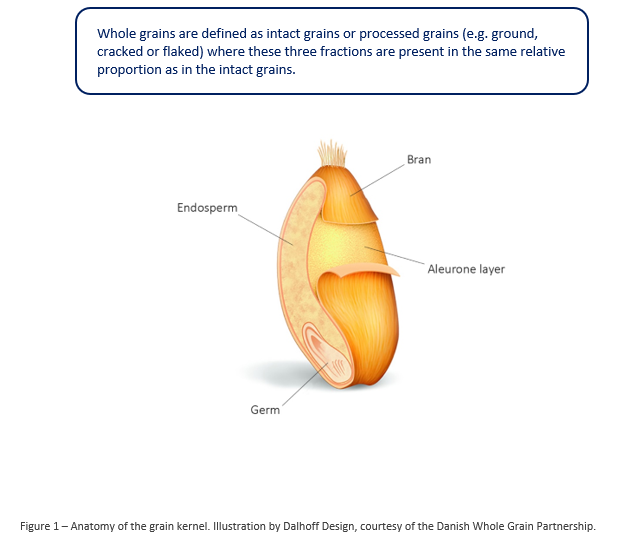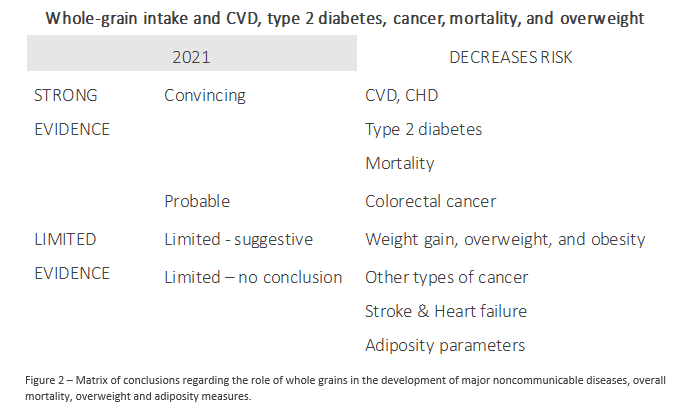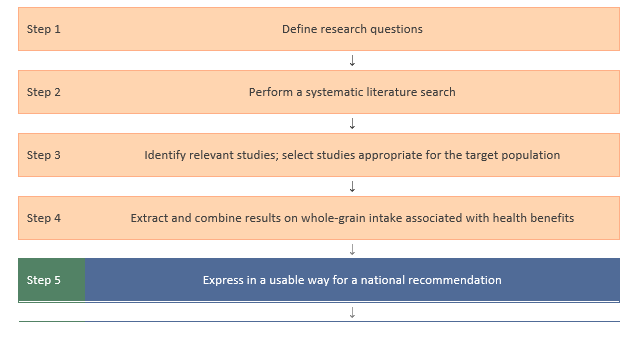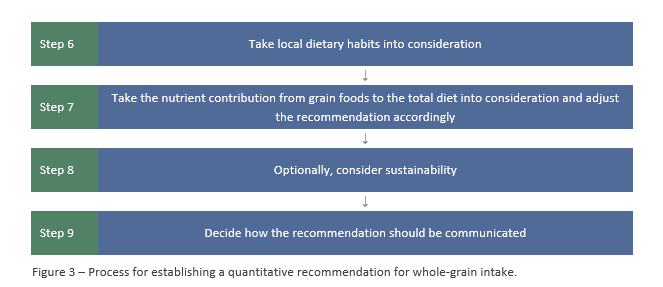Health effects of whole grains
Wholegrain: definition, evidence base reviwe, sustainability aspects, and consideration for dietary quideline.
A summary
The report considers the definition of whole grains and whole-grain products, it reviews the evidence regarding the health benefits of whole-grain consumption, provides insight into the sustainability aspects of whole grains, and gathers knowledge of relevant aspects necessary to the establishment of national recommendations for whole-grain consumption.
Defining whole grains
Seeds from grass species – also called grains or caryopses – include three distinct fractions: the endosperm, the germ, and the bran.

The most widely consumed cereal grains are wheat, rice, barley, maize (corn), rye, oats and millets. Theoretically, intact seeds from all plants from the grass family could be defined as whole grains. However, scientific evidence for beneficial health effects is almost entirely based on the most commonly consumed grains. So-called “pseudo-cereals” (amaranth, buckwheat, quinoa) can be used in similar ways as cereals, since their culinary use is comparable. Their nutrient content is somewhat similar, so the nutritional impact of replacing cereal grains in the diet with pseudo-cereals is probably limited. However, seeds from pseudo-cereals do not contain some of the bioactive compounds found in true cereals.
Of the three main fractions, the bran and germ parts have the highest concentrations of vitamins, minerals, dietary fibre, and a series of other bioactive compounds. Many of these nutrients and bioactive compounds are linked to the health benefits of whole-grain consumption. Whole grains and whole-grain products contain these nutrients and bioactive compounds in significantly higher proportions than refined-grain products.

To avoid misleading consumers, whole-grain food products should contain a specified minimum amount of whole grains. Preferably, whole grains should be the main ingredient in a whole-grain food product. Also, the designation “whole grain” could be reserved to specific food categories, e.g. bread, pasta, and breakfast cereals, which are natural components of a healthy diet. We suggest that foods consisting of only one ingredient, like flour or rolled oats, should be 100% whole grain to use the designation “whole grain”. In composite foods, more than 50% of the dry matter should be whole grains. In multicomponent foods (consisting of more than one food group) such as meals, the whole-grain criteria should refer to the cereal part, e.g. the bun in a burger or the crust in a pizza.
Since many consumers may regard foods labelled “whole grain” as healthy, it is advisable that such foods should meet accepted standards for healthy foods, e.g. nutrient profiles on salt, fat and sugars.
Evidence of health benefits
A review was conducted, with the aim of gathering the latest and best level of evidence available concerning the associations between whole-grain intake and the development of cardiovascular diseases, type 2 diabetes, cancer, risk of overall mortality, and overweight. There is strong epidemiological evidence of a protective role of whole grains on the risk of overall cardiovascular, coronary heart disease, type 2 diabetes, colorectal cancer and mortality.
The results of recent good quality meta-analyses, expert reports and of the present review show there is consistent evidence that an intake of about 90 g of whole-grain products per day significantly reduces the risk of these diseases and overall mortality.Significant risk reductions for these diseases can be achieved with as little as one-two servings of whole-grain products per day. Also, protective effects are clearly seen for higher whole-grain intakes, with further risk reductions with intakes up to 6.5–7.5 servings for some of the observed associations.

There is limited evidence suggestive of a protective role of whole grains on the risk of weight gain, overweight and obesity. Even though the evidence is limited at present, it is generally consistent and shows a trend towards an inverse, albeit very small, risk reduction.There is not enough evidence available at present to judge the potential role of whole grains on the risk of heart failure, stroke, other types of cancer, and adiposity parameters like waist circumference, body fat percentage, fat mass and fat-free mass.

Unwanted substances and contaminants
A variety of unwanted substances or contaminants from different sources can, as well as in other foods be found in whole grains and whole-grain products. For whole grains and whole-grain products, levels of such substances do not differ considerably from the levels found in refined grains or refined-grain products. As long as the maximum levels stipulated by the EU for different groups of foods are not exceeded, unwanted substances and contaminants in whole grains and whole-grain products pose very few food safety or health concerns, but awareness must be kept regarding potential problems deriving mainly from arsenic, but also aflatoxins and acrylamide to some extent. Consumer education programs and campaigns can provide consumers and professionals with knowledge on how to use cereals in safe manners.
Sustainability aspects
Grains and cereals are, together with vegetables, fruits, legumes and pulses, among the food groups with the lowest climate impact per kg of food. When comparing the different types of grains and cereals, rice tends tohave a higher impact than wheat, rye and oats.Few studies have compared whole-grain products with products made from refined grains, but whole-grain bread might have a slightly lower climate impact per kg than bread made from refined grains. Although grains make up a relatively large proportion of the typical European diet, they only contribute a smaller part of the climate impact from a total diet due to the high climate impact from most animal products. Regardless of diet type, whole grains can always play a significant role and can help improve the nutritional content of a diet. When transitioning to a more healthy and sustainable plant-based diet with fewer animal products, whole-grain products become even more important. Together with legumes, grains contribute with essential amino acids. Further, whole-grain products have a significant content of those minerals that may be limited in a more plant-based diet, e.g. iron and zinc.
Consideration for a dietary quideline
Establishing a recommendation for whole-grain intake should be based on the best scientific evidence available for associations between whole-grain intake and incidence of non-communicable diseases and mortality.The amount of whole grains that is shown to provide health benefits should be evaluated in the context of local dietary habits and nutrient recommendations. Adding a sustainable perspective is expected to increase the whole-grain recommendation at the expense of animal-based foods, since the contribution of essential nutrients from whole-grain food products in a healthier and more sustainable diet becomes highly relevant. It is important to emphasize that different types of whole grains should be consumed, since they contribute with different nutrients and other compounds.Whether a whole-grain recommendation is communicated to consumers in grams, grams of products or no. of servings/portions, and whether it is expressed per energy unit or per day, is for the responsible health authority to decide based on local practice.
Figure 3 illustrates all the steps included in the process for establishing a quantitative recommendation for whole-grain intake. Steps 1-4 are already covered and described in detail in the report “Whole grain: definition, evidence base review, sustainability aspects and considerations for a dietary guideline” available here.
.
